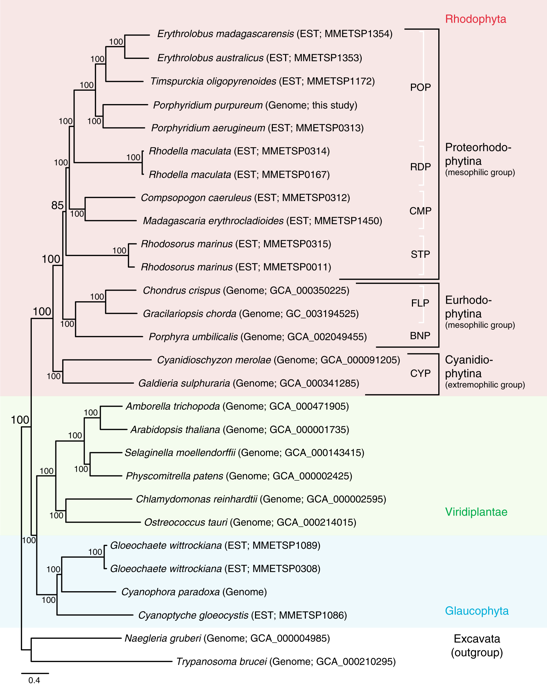当前位置:
X-MOL 学术
›
Nat. Commun.
›
论文详情
Our official English website, www.x-mol.net, welcomes your
feedback! (Note: you will need to create a separate account there.)
Expansion of phycobilisome linker gene families in mesophilic red algae.
Nature Communications ( IF 14.7 ) Pub Date : 2019-10-23 , DOI: 10.1038/s41467-019-12779-1 JunMo Lee 1, 2, 3 , Dongseok Kim 1 , Debashish Bhattacharya 2 , Hwan Su Yoon 1
Nature Communications ( IF 14.7 ) Pub Date : 2019-10-23 , DOI: 10.1038/s41467-019-12779-1 JunMo Lee 1, 2, 3 , Dongseok Kim 1 , Debashish Bhattacharya 2 , Hwan Su Yoon 1
Affiliation

|
The common ancestor of red algae (Rhodophyta) has undergone massive genome reduction, whereby 25% of the gene inventory has been lost, followed by its split into the species-poor extremophilic Cyanidiophytina and the broadly distributed mesophilic red algae. Success of the mesophile radiation is surprising given their highly reduced gene inventory. To address this latter issue, we combine an improved genome assembly from the unicellular red alga Porphyridium purpureum with a diverse collection of other algal genomes to reconstruct ancient endosymbiotic gene transfers (EGTs) and gene duplications. We find EGTs associated with the core photosynthetic machinery that may have played important roles in plastid establishment. More significant are the extensive duplications and diversification of nuclear gene families encoding phycobilisome linker proteins that stabilize light-harvesting functions. We speculate that the origin of these complex families in mesophilic red algae may have contributed to their adaptation to a diversity of light environments.
中文翻译:

嗜温红藻中藻胆体连接子基因家族的扩展。
红藻(Rhodophyta)的共同祖先经历了大规模的基因组减少,从而丢失了25%的基因库存,随后将其分为物种贫瘠的极端嗜蓝藻(Cyanidiophytina)和分布广泛的中温红藻。鉴于嗜温菌辐射基因的高度减少,其成功的原因令人惊讶。为了解决后一个问题,我们将单细胞红藻紫斑紫菜的改良基因组装配与其他藻类基因组的多种集合相结合,以重建古代内共生基因转移(EGT)和基因重复。我们发现与核心光合作用机制相关的EGTs可能在质体建立中发挥了重要作用。更重要的是编码稳定光收集功能的藻胆体接头蛋白的核基因家族的广泛复制和多样化。我们推测,这些复杂的家族起源于嗜温红藻,可能有助于它们适应多种光照环境。
更新日期:2019-10-24
中文翻译:

嗜温红藻中藻胆体连接子基因家族的扩展。
红藻(Rhodophyta)的共同祖先经历了大规模的基因组减少,从而丢失了25%的基因库存,随后将其分为物种贫瘠的极端嗜蓝藻(Cyanidiophytina)和分布广泛的中温红藻。鉴于嗜温菌辐射基因的高度减少,其成功的原因令人惊讶。为了解决后一个问题,我们将单细胞红藻紫斑紫菜的改良基因组装配与其他藻类基因组的多种集合相结合,以重建古代内共生基因转移(EGT)和基因重复。我们发现与核心光合作用机制相关的EGTs可能在质体建立中发挥了重要作用。更重要的是编码稳定光收集功能的藻胆体接头蛋白的核基因家族的广泛复制和多样化。我们推测,这些复杂的家族起源于嗜温红藻,可能有助于它们适应多种光照环境。













































 京公网安备 11010802027423号
京公网安备 11010802027423号